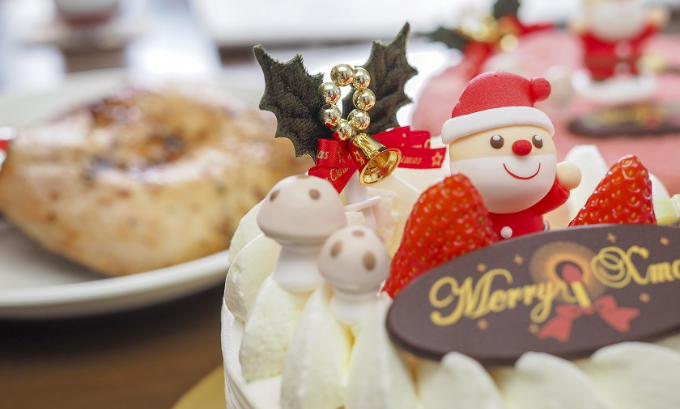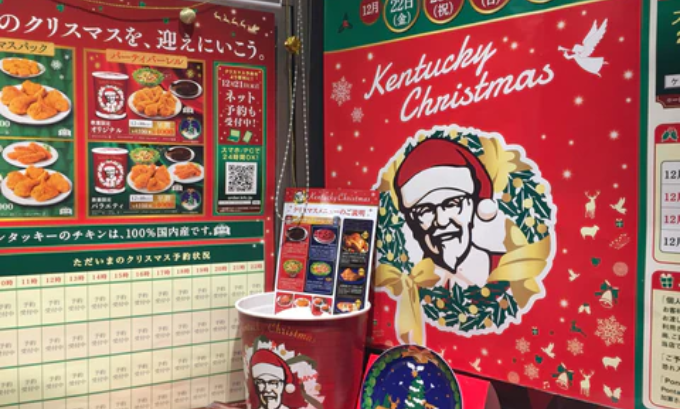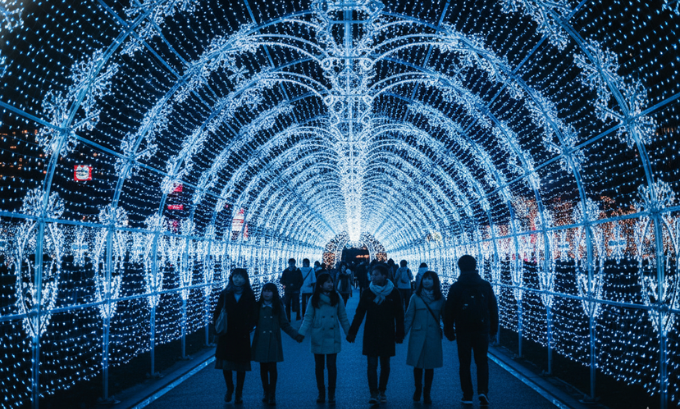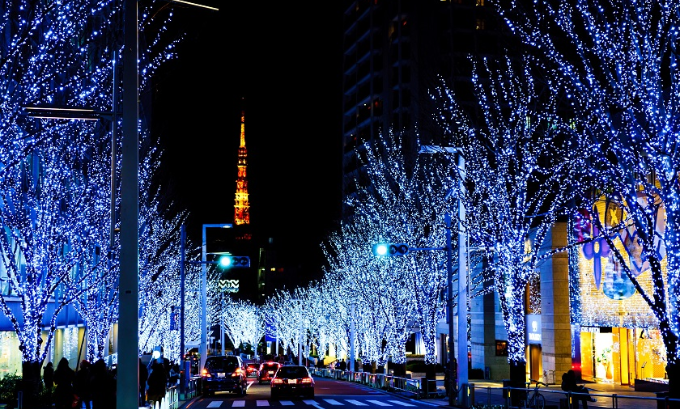Christmas in Japan offers a fascinating blend of Western traditions and distinctive Japanese customs. While only about 1% of Japan’s population identifies as Christian, Christmas has evolved into a beloved cultural celebration that emphasizes romance, illuminations, and delicious food traditions.
Japan transforms Christmas into something uniquely beautiful—a romantic holiday filled with dazzling light displays, special cakes, and memorable experiences. From bustling Tokyo streets adorned with winter illuminations to couples enjoying intimate Christmas Eve dates, this holiday has found its own special meaning in Japanese culture. The celebration centers around creating magical moments rather than religious observance, making it accessible to people of all backgrounds.
This guide explores how Christmas unfolds across Japan, from the iconic KFC tradition to stunning theme park celebrations, helping you understand and experience this captivating Japanese interpretation of the holiday season.
Table of Contents
How Christmas Arrived in Japan
Christmas first came to Japan in the 16th century through Francis Xavier, a Catholic missionary who introduced Christianity to the country in 1549. However, the holiday disappeared during Japan’s period of isolation (1633-1853) when Christianity was banned.
Christmas experienced a revival during the Meiji period (1868-1912) as Japan reopened to Western influence. Unlike Western countries where Christmas carries deep religious significance, Japan adopted the holiday’s aesthetic and commercial aspects while developing its own unique traditions. This cultural adaptation reflects Japan’s remarkable ability to incorporate foreign customs and make them distinctly Japanese.
The post-World War II era saw Christmas gain significant popularity as American culture influenced Japanese society. Department stores began elaborate Christmas displays, and the holiday became associated with consumerism, romance, and Western sophistication. Today, Christmas in Japan represents modernity, international culture, and seasonal celebration rather than religious devotion.
Japanese Christmas Traditions That Make the Season Special
Japanese Christmas Cake: A Sweet Symbol of Prosperity
The Japanese Christmas cake (Kurisumasu Ke-ki) stands as perhaps the most iconic holiday tradition. These beautiful white sponge cakes are decorated with whipped cream and fresh strawberries, creating an elegant dessert that symbolizes prosperity and good fortune.
Unlike heavy Western fruitcakes, Japanese Christmas cakes are light and airy, reflecting Japanese preferences for delicate flavors and beautiful presentation. The white cream represents snow, while red strawberries add festive color. Families order these cakes weeks in advance from bakeries, and they’re typically enjoyed on Christmas Eve during intimate gatherings.

The tradition began in the 1910s when Japanese confectioners adapted Western cake-making techniques. Today, premium versions can cost hundreds of dollars and feature elaborate decorations. Many couples share a Christmas cake as part of their romantic Christmas Eve celebration, making it both a culinary tradition and symbol of love.
KFC Christmas Tradition: A Uniquely Japanese Phenomenon
Japan’s KFC Christmas tradition began in the 1970s with a brilliant marketing campaign featuring the slogan “Kurisumasu ni wa kentakkii!” (Kentucky for Christmas!). This campaign convinced Japanese families that fried chicken was a traditional American Christmas meal, creating one of the most successful marketing stories in history.

Today, Japanese families order their Christmas KFC weeks in advance, and the restaurants experience their busiest sales period of the year. Special Christmas sets include chicken, cake, and wine, transforming fast food into a holiday feast. Some locations require reservations, and people wait in long lines to collect their Christmas orders.
This tradition demonstrates Japan’s unique approach to adopting foreign customs. While Americans might find it unusual, KFC Christmas has become deeply embedded in Japanese culture. The success stems from practical factors—chicken is more accessible than turkey, and KFC marketed itself as authentically Western during a time when Japan was embracing international culture.
For insights into modern Japanese culture and traditions, visit japanese family dynamics to understand how contemporary celebrations fit into broader cultural patterns.
Winter Illuminations: Japan’s Spectacular Light Displays
Winter illuminations represent the most visually stunning aspect of Christmas in Japan. Cities across the country transform into wonderlands of light from November through February, creating romantic atmospheres that attract millions of visitors.

Tokyo’s Premier Illumination Destinations:
- Tokyo Midtown: Features sophisticated LED displays and artistic installations
- Roppongi Hills: Offers panoramic city views combined with elaborate light shows
- Shibuya Blue Cave: Creates an enchanting tunnel of blue lights along the streets
National Illumination Highlights:
- Nabana no Sato (Mie Prefecture): One of Japan’s largest illumination parks featuring themed displays
- Jewels of Shonan (Kanagawa): Coastal illuminations with ocean views
- Kobe Luminarie: Memorial illumination display honoring earthquake victims
These illuminations cost millions of dollars to create and maintain, demonstrating the commercial and cultural importance of Christmas in Japan. Couples consider visiting illuminations essential Christmas activities, often marking the beginning of romantic relationships. The displays combine Japanese attention to detail with spectacular scale, creating uniquely beautiful experiences.
To explore more about Japan’s innovative approaches to entertainment and culture, check out japan nightlife for additional cultural experiences.
Christmas Markets: Bringing European Charm to Japan
Japanese Christmas markets blend German-inspired traditions with local flavors, creating unique seasonal experiences. These markets offer traditional crafts, seasonal treats, and warm beverages, bringing European Christmas atmosphere to Japanese cities.
Notable Christmas Markets:
- Yokohama Red Brick Warehouse Christmas Market: Features authentic German vendors and traditional crafts
- Tokyo Christmas Market: Located in Hibiya Park, offering German food and handmade ornaments
- Osaka German Christmas Market: One of Japan’s largest, featuring live music and traditional German cuisine
These markets import authentic German vendors, creating genuine European experiences. Visitors enjoy glühwein (mulled wine), bratwurst, and handmade decorations while experiencing German Christmas culture. The markets represent Japan’s appreciation for international traditions and attention to authentic cultural experiences.
Japanese artisans also participate, creating fusion products that blend European Christmas themes with Japanese craftsmanship. This cultural exchange demonstrates how Christmas in Japan serves as a bridge between international and local traditions.
Theme Park Christmas: Disney Magic and Universal Wonder
Japanese theme parks elevate Christmas celebrations to spectacular heights, creating magical experiences that attract visitors worldwide. These parks combine Western Christmas imagery with Japanese attention to detail and customer service.

Tokyo Disneyland Christmas Events
Disneyland Tokyo transforms into a Christmas wonderland from November through December, featuring exclusive parades, shows, and merchandise. The park’s Christmas Fantasy parade includes Disney characters in festive costumes, elaborate floats, and snow effects that create magical moments for all ages.
Special Christmas-themed attractions and decorations cover the entire park, while exclusive holiday merchandise becomes highly coveted collectibles. Disney’s Christmas events demonstrate the commercial success of Christmas in Japan, attracting families and couples seeking magical experiences.
Universal Studios Japan Christmas Spectacular
Universal Studios Japan (Osaka) presents its NO LIMIT! Christmas event, featuring the Hogwarts Magical Night projection show and themed attractions. The park combines Hollywood magic with Christmas celebration, creating immersive experiences that showcase advanced technology and storytelling.
These theme park celebrations demonstrate how Japanese businesses have embraced Christmas as a major commercial opportunity while creating genuinely magical experiences that exceed international standards.
Hokkaido: Japan’s White Christmas Destination
Hokkaido offers Japan’s most authentic white Christmas experience, with snow-covered landscapes and winter activities that create picture-perfect holiday scenes. The island’s ski resorts, hot springs, and winter festivals provide romantic settings that attract couples and families seeking traditional Christmas atmospheres.
Hokkaido Christmas Highlights:
- Sapporo Snow Festival: While typically held in February, winter preparations begin during Christmas season
- Niseko Ski Resort: Offers world-class skiing with Christmas celebrations
- Otaru Canal: Historic canal lined with Christmas illuminations and romantic restaurants
Hokkaido’s natural beauty combined with Christmas celebrations creates experiences that rival traditional Western Christmas destinations. Hotels offer Christmas dinner packages, and the snowy landscape provides perfect backdrops for romantic Christmas dates.
The region’s Christmas celebrations blend Japanese hospitality with winter sports culture, creating unique holiday experiences. Visitors can enjoy traditional Japanese hot springs (onsen) after skiing, combining relaxation with Christmas celebration in uniquely Japanese ways.
For more information about traveling in Japan, explore resources at techbullion.in to understand practical aspects of visiting during the holiday season.
Christmas vs. New Year: Understanding Japanese Holiday Priorities
While Christmas receives significant attention, New Year’s (Oshogatsu) remains Japan’s most important holiday. This contrast reveals how Japanese culture adapts foreign traditions while maintaining core cultural values.
Christmas Focus:
- Romance and couples
- Western-style celebration
- Commercial and entertainment emphasis
- Individual and small group activities
New Year Focus:
- Family gatherings and tradition
- Japanese cultural practices
- Spiritual reflection and renewal
- Community and ancestral connections
Christmas serves as a warm-up to the more significant New Year celebration, when families reunite, eat traditional osechi dishes, and visit temples for hatsumode (first shrine visit). This pattern shows how Japan maintains cultural priorities while embracing international influences.
The difference also reflects generational changes—younger Japanese often prioritize Christmas romance, while older generations focus on New Year traditions. Both holidays coexist, serving different social and cultural functions within Japanese society.
Understanding these priorities helps visitors appreciate how Christmas fits into broader Japanese cultural patterns. The holiday season becomes a month-long celebration combining Western excitement with Japanese tradition.
Modern Japanese Christmas: Contemporary Trends and Changes
Contemporary Japanese Christmas continues evolving, incorporating new technologies, changing social patterns, and global influences. Social media has transformed how people share Christmas experiences, while economic changes affect celebration styles.
Current Trends:
- Instagram-worthy experiences: Illuminations and decorations designed for social media sharing
- Sustainable celebrations: Growing environmental awareness affecting decoration choices
- International fusion: Incorporating Christmas traditions from various countries
- Experience over materialism: Focus on creating memories rather than gift-giving
Young Japanese increasingly view Christmas as an international cultural experience, exploring various global traditions through food, music, and decorations. This cosmopolitan approach reflects Japan’s position as a global cultural hub.
Technology integration includes LED illuminations controlled by smartphones, virtual Christmas experiences, and AI-powered holiday recommendations. These innovations demonstrate how Japan continues adapting Christmas to contemporary lifestyles.
The COVID-19 pandemic also influenced celebrations, emphasizing smaller gatherings and outdoor illuminations over crowded events. These changes may permanently alter how Christmas is celebrated in Japan.
For insights into Japan’s technological innovations and cultural trends, visit how to use apple ai to understand how technology shapes modern Japanese experiences.

Planning Your Japanese Christmas Experience
Visiting Japan during Christmas season offers unique experiences unavailable elsewhere. Planning ahead ensures you experience the best of Japanese Christmas culture while avoiding crowds and securing reservations.
Essential Christmas Experiences:
- Book illumination tours: Popular spots fill quickly during peak season
- Reserve Christmas dinner: High-end restaurants require advance booking
- Visit theme parks: Purchase tickets early for special Christmas events
- Experience traditional and modern: Balance Western-style celebrations with Japanese innovations
Practical Tips:
- Christmas Eve is busier than Christmas Day for restaurants and attractions
- Many attractions offer Christmas season passes with multiple venue access
- English-language Christmas events are available in major cities
- Weather can be cold, so dress warmly for outdoor illuminations
Cultural Considerations:
- Christmas is more about atmosphere than religious observance
- Couples activities are common; solo travelers might feel out of place at some romantic venues
- Gift-giving is less common than in Western countries
- Photography is encouraged at most illumination displays
For comprehensive Japan travel information, including seasonal considerations and cultural insights, explore resources at bullet train japan for transportation planning.
Frequently Asked Questions
Is Christmas a public holiday in Japan?
No, Christmas is not a public holiday in Japan. December 25th is a regular working day, though many businesses acknowledge the holiday with decorations and special offerings.
Do Japanese people exchange gifts at Christmas?
Gift-giving is less common than in Western countries, but some families and couples do exchange presents. The focus is more on experiences and food than material gifts.
Can non-Christians enjoy Christmas in Japan?
Absolutely. Japanese Christmas is primarily cultural rather than religious, making it accessible and enjoyable for people of all backgrounds.
Are Christmas decorations available year-round in Japan?
Christmas decorations typically appear in stores from November and are removed shortly after New Year’s. They’re not commonly available year-round.
How expensive is celebrating Christmas in Japan?
Costs vary widely. Illuminations are often free, while special Christmas dinners and theme park events can be expensive. Budget options exist for all aspects of celebration.
Do Japanese children receive presents from Santa?
Some families have adopted this Western tradition, but it’s not universal. Children are more likely to receive New Year’s money (otoshidama) than Christmas presents.
Experience the Magic of Japanese Christmas
Christmas in Japan demonstrates the country’s remarkable ability to embrace foreign traditions while creating something uniquely beautiful. From romantic illuminations to delicious Christmas cakes, from KFC feasts to magical theme park celebrations, Japanese Christmas offers experiences unavailable anywhere else in the world.
Whether you’re planning a visit or simply curious about cultural adaptations, Japanese Christmas reveals how traditions evolve and find new meanings across cultures. The holiday’s emphasis on beauty, romance, and shared experiences reflects core Japanese values while celebrating international connection.
This unique Christmas celebration continues evolving, incorporating new technologies, global influences, and changing social patterns. As Japan maintains its position as a cultural bridge between East and West, Christmas serves as a perfect example of successful cultural adaptation.
For more insights into Japanese culture and travel experiences, explore mindjournal.co for current travel information and cultural guides.

